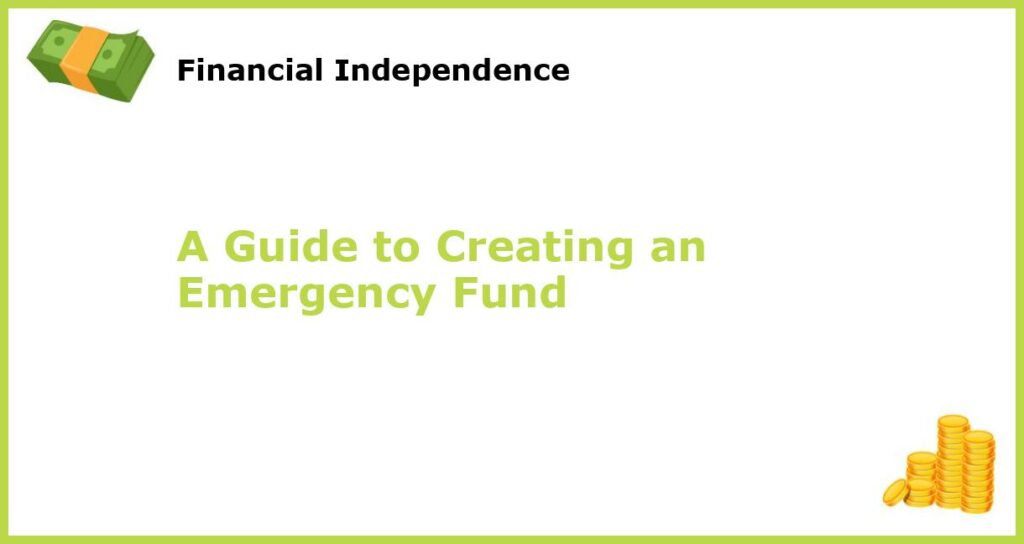In a world that is fast-paced and unpredictable, creating an emergency fund is essential. Emergencies happen when we least expect them, and not being prepared can have significant financial consequences. An emergency fund is fundamental in helping you stay afloat during difficult times without having to rely on high-interest loans or credit cards. Below are ten tips for creating an emergency fund.
1. Start Small and Build Up
The first step to creating an emergency fund is to start small and gradually build up over time. Set a realistic savings goal that you can achieve in a reasonable amount of time, say six months or a year, and work towards it diligently. Every little bit counts, so don’t be discouraged if you can’t save a lot at first.
For instance, if your goal is to save $2000 in six months, you need to save approximately $333 every month. Saving in small amounts will make the process less daunting, and you will be less likely to give up along the way.
Furthermore, starting small will help you to form a habit of saving, which is essential in achieving long-term financial stability.
2. Devise a Plan and Stick to It
Haphazard saving without a plan can be problematic. To achieve your goal of creating an emergency fund, it’s necessary to have a solid plan in place.
Start by determining how much you need to save each month to reach your emergency fund goal. Then create a budget and cut back on unnecessary expenses to free up money to save.
Track your progress regularly and make adjustments where necessary to ensure that you stick to your saving plan. Remember, discipline and consistency are critical in creating an emergency fund.
3. Consider Automatic Savings
Automatic savings are an effective way to build an emergency fund without even thinking about it.
You can set up a direct deposit from your paycheck or establish automatic transfers from your checking account to your emergency fund account. By doing so, you won’t have to think about saving; it will happen automatically.
This is an excellent strategy if you’re the kind of person who struggles to save consistently or is prone to spending money on unnecessary expenses.
4. Make Saving a Habit
Like any other habit, saving requires discipline and consistency. Make a routine of setting aside a certain amount of money every week or month towards your emergency fund.
Make it easier by setting up reminders, automating your savings or visualizing your goal. Habits are developed by creating routines, so make savings non-negotiable.
If you’re finding it challenging to stick to the habit, try and motivate yourself by thinking about the comfort you will feel in moments of emergency when you’re not in financial distress.
5. Have a Separate Account for Your Emergency Fund
It’s crucial that your emergency fund is in a separate account from your day-to-day spending account.
Having a separate account will make it easier to track progress and ensure that you don’t accidentally spend your emergency savings on other expenses.
Consider opening a high-yield savings account that will earn you interest on your emergency fund. Earning interest will help grow your emergency fund faster.
6. Prioritize Your Emergency Fund
Creating an emergency fund should be a top priority. It’s important to ensure that you have enough saved up to cover unexpected expenses such as car repairs, medical bills or job loss.
If paying off debts is your priority, consider incorporating your emergency fund goal into your larger financial plan. You can allocate a certain amount towards your emergency fund each month while you work on paying off other debts concurrently.
7. Be Consistent and Persistent
Creating an emergency fund requires consistency and persistence. It’s easy to give up when you feel like you’re not making progress; however, the key is to keep going.
Make it a goal to save consistently each month and keep up the momentum. There is no “perfect” way of creating an emergency fund, but consistency is essential.
8. Reevaluate Your Spending Habits
In creating an emergency fund, you may need to reevaluate your current spending habits.
Look closely at your budget and determine where you can cut back. Be honest with yourself and make the necessary changes. This may mean cutting back on eating out, shopping for clothes, or unnecessary subscriptions.
Furthermore, you might consider sustainable alternative solutions that are necessary to create a comfortable emergency fund.
9. Set Realistic Goals
It’s fundamental to set realistic savings goals that you know you can achieve.
It’s important to understand that creating an emergency fund is not an overnight process, but rather a gradual one that requires patience and dedication.
Setting unrealistic goals can lead to frustrations that may lead to giving up on savings altogether.
10. Celebrate Milestones and Progress
Creating an emergency fund is a significant financial milestone. It’s crucial to celebrate your achievements along the way.
Set small rewards for yourself when you reach a savings goal or milestone.
These celebrations should not be extravagant but should be a way of acknowledging the hard work, sacrifice and making it easier to continue the saving habit.







